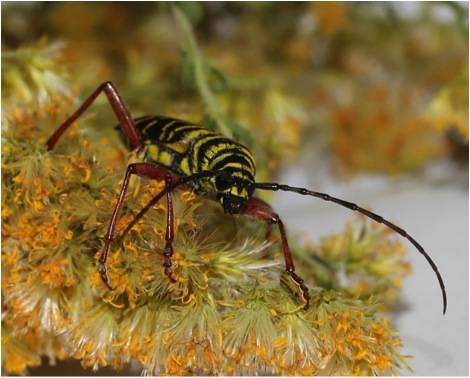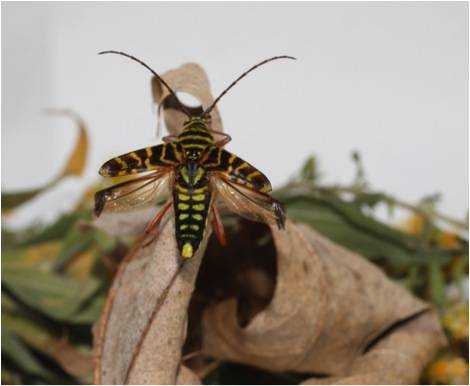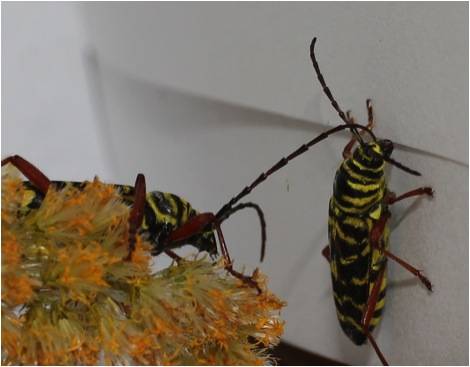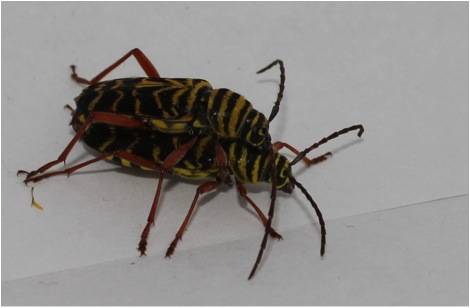
After a long day in the lab, tinkering with the bulky, finicky machines that allow me to detect and measure beetle pheromones, I finally make my way home to relax with an hour (or two) of cable. When I reach my back stoop, the sun is fading behind the church across the parking lot, and the back light illuminates the entryway. There beside the rectangular keypad is a longhorn beetle — the very beetle I spent all day studying.
I watch as the beetle waves its antennae around, discovering a set of smells undetectable to the human nose. More than just a smell, these pheromones are information-rich messages in the form of complex molecules. The beetle thrashes its lengthy antennae through the thick air, probing as many invisible molecules as possible, perceiving the hidden messages only insects can decode. It perches for a moment with its hard outer wings outstretched in anticipation of flight, and flies the short distance to a nearby tree. It is undoubtedly a she for, after a moment of exploration, she everts a slender tube from the end of her abdomen and pushes this ovipositor into a crevice in the bark. She relieves her swollen abdomen by releasing an egg through the ovipositor and under the protection of the hard bark. After securing homes for a few more of her eggs, she once again perches in anticipation of flight and ambles through a barrage of molecules carried by the wind, following a new set of pheromones to a new adventure.

She is not a bad mother, just satisfied with the relative protection she has provided for her offspring. These eggs are well veiled under the cover of the hard, cavernous bark. The micro-world, however, holds many unforeseen dangers lurking in places too tiny to be revealed to our giant eyes. There are many threats to a protein-packed treat unable to move away from a hungry predator. Despite these hazards to survival, the majority of these eggs will hatch and become ravenous eating machines.
Longhorn beetle larvae look like any other beetle grub — that is, until you realize that their head is almost entirely taken up by a set of massive jaws. These mandibles are not for show. The larvae exert a force beyond that of our own measly jaws to chomp through the hard wood beneath the outer bark. They must extract all of their nutrients from this unforgiving, cellulose-rich diet to grow into the next stage of development. Five of these developmental hurdles stand between them and adulthood. By this time, they have had to endure the monotony of a wood-dwelling life for months, unable to escape from their mother’s choice of birthplace until they become adults themselves. If only they too had cable.

From this uniform diet, the beetle must piece together enough carbohydrates, fats, and amino acids — the building blocks of proteins — to develop from an egg into a complex adult. Glucose is a staple carbohydrate in any diet and, luckily for the longhorn beetles, wood is made up of long chains of this molecule in the form of cellulose. However, cellulose is unbreakable unless you have the right tools — or in this case the right enzyme — to break the tough bonds holding the glucose molecules securely together. Wood-eating insects such as longhorn beetles and termites have developed a partnership with bacteria that are able to produce this enzyme and survive the harsh environment of a beetle gut. Even with this life-giving enzyme it can take years for longhorn larvae to develop into adults. Until they have enough nutrients to make it to adulthood, the larvae must keep on chewing. The pivotal choice for a mother, therefore, is on what tree to leave her precious eggs, because her offspring will have to live with her choice for the next 1–40 years of their lives, with the record held by the ivory-marked beetle.
As adults, longhorn beetles face an entirely new set of natural assaults. Protection from the elements requires a hefty armor composed of layer upon layer of tough chitin and proteins, topped with a thin layer of wax. The exoskeleton armor must be strong and flexible enough to escape predators, as well as watertight to prevent evaporation. This top coat of wax plays an essential role for insect survival in places where there is little or no water available, sealing in the little water the beetle extracts from its food. But this wax isn’t just for waterproofing the exoskeleton, it also contains a unique and complex set of long molecules packed with hydrogens and carbons, appropriately named hydrocarbons. Without the power of speech to guide formal introductions, these beetles use an effective alternative: The waxy hydrocarbons on their outer armor. These molecules are just as jam-packed with information as the airborne pheromones, with the added benefit of remaining on their body.
Insect communication is a performance art. Ultra-sensitive sensors in the antenna must pick up minute quantities of pheromones carelessly tossed about in the wind. These molecules will reveal if the source of the pheromone is close and whether it hails from a male or a female of their same species. Following the trail can be an arduous sport, with only a few molecules at a time guiding their journey. They are led by the whims of the prevailing winds and must follow the winding, curving path until the scent thickens. The complex journey does not end if they reach the elusive target. After landing a careful distance away from the unknown source, the crucial moment has arrived. But, is this a suitable mate or a ravenous predator disguised in off-brand pheromones? Both parties suspiciously wave their antennae in front of them attempting to sample the waxy information-rich pheromones on the outside of their acquaintance’s body. They tap and rake their antennae over the stranger, patting them down for hidden messages about who they are and what they do. Only after this intricate dance will a decision be made to court, feed, or leave.

A seemingly unimportant layer of wax can hold the fate of the insect in its slippery hands. This critical component to survival and reproduction can only be produced if the beetle can pull together all of the essential molecules it needs from its food. Longhorn beetles, however, only have one source of food until they can emerge as an adult. I am left wondering: What about those poor beetles that are stuck developing in a spindly, second-rate branch? Will they be able to piece together all of the nutrients they need to make a quality waxy name tag, or will they suffer the consequences akin to a permanent bad hair day?
Back at the lab, I look through pictorial representations of the waxy hydrocarbons — the end result spit out by the bulky machine in my lab — in search of what actually matters for these beetles. So far this is clear: Beetles certainly do vary in their waxy hydrocarbons, and size matters. Larger beetles have a more complex and robust set of hydrocarbons than the smaller ones. What I don’t yet know is if this variation even matters, sometimes even the spindly dudes with B.O. have a chance to score with the ladies, and this might be the case with my beetles. It’s exciting questions like these that keep me interested in these beetles and, while every answered question somehow leads to ten more unanswered ones, I keep trying to answer as many as I can.
Written by Christina Silliman, PhD candidate in the Department of Entymology at the University of Illinois.
All photos taken by the author.
~~*~~
Smile Politely is proud to introduce a new running series we are calling “Science Politely” that will feature the work of graduate students at the University of Illinois throughout November and December. Working in collaboration with the students in a graduate course in Integrative Biology, Science Politely is a collaboration aimed at bridging the gap between town and university, between scientist and citizen, and between research and culture.








